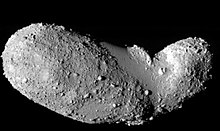25143 Itokawa

Greyscale (black & white) image of 25143 Itokawa as observed by JAXA's Hayabusa
|
|
| Discovery | |
|---|---|
| Discovered by | LINEAR |
| Discovery date | 26 September 1998 |
| Designations | |
|
Named after
|
Hideo Itokawa |
| 1998 SF36 | |
|
Apollo asteroid, Mars-crosser asteroid |
|
| Orbital characteristics | |
| Epoch 18 August 2005 (JD 2453600.5) | |
| Aphelion | 1.695 AU (253.520 Gm) |
| Perihelion | 0.953 AU (142.568 Gm) |
| 1.324 AU (198.044 Gm) | |
| Eccentricity | 0.280 |
| 1.52 a (556.355 d) | |
|
Average orbital speed
|
25.37 km/s |
| 294.502° | |
| Inclination | 1.622° |
| 69.095° | |
| 162.760° | |
| Physical characteristics | |
| Dimensions | 535 × 294 × 209 m |
| Mass | (3.51±0.105)×1010 kg, (3.58±0.18)×1010 kg |
|
Mean density
|
1.9 ±0.13 g/cm³, 1.95 ± 0.14 g/cm³ |
| ~0.1 mm/s² | |
| ~0.2 m/s | |
| 0.5055 d (12.132 h) | |
| Albedo | 0.53 |
| Temperature | ~206 K |
|
Spectral type
|
S |
| 19.2 | |
25143 Itokawa (/ˌiːtoʊˈkɑːwə/; Japanese: イトカワ [itokawa]) is an Apollo and Mars-crosser asteroid. It was the first asteroid to be the target of a sample return mission, the Japanese space probe Hayabusa, and the smallest asteroid photographed by a spacecraft.
The asteroid was discovered in 1998 by the LINEAR project and was given the provisional designation 1998 SF36. In August 2003, it was officially named after Hideo Itokawa, a Japanese rocket scientist.
Itokawa is an S-type asteroid. Radar imaging by Goldstone in 2001 observed an ellipsoid 630 ± 60 m long and 250 ± 30 m wide.
The Hayabusa mission confirmed these findings and also suggested that Itokawa may be a contact binary formed by two or more smaller asteroids that have gravitated toward each other and stuck together. The Hayabusa images show a surprising lack of impact craters and a very rough surface studded with boulders, described by the mission team as a 'rubble pile'. Furthermore, the density of the asteroid is too low for it to be made from solid rock. This would mean that Itokawa is not a monolith but rather a 'rubble pile' formed from fragments that have cohered over time. Based on Yarkovsky–O'Keefe–Radzievskii–Paddack effect measurements, a small section of Itokawa is estimated to have a density of 2.9 g/cm³, whereas a larger section is estimated to have a density of 1.8 g/cm³.
...
Wikipedia
